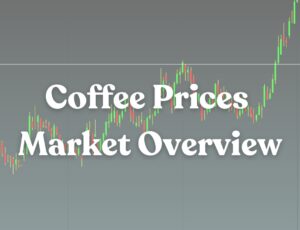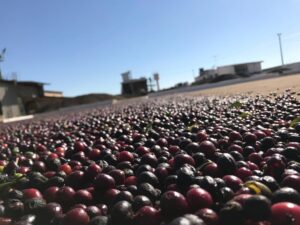You may have heard about the increased volatility in coffee prices, but there’s much more behind the final green price: interest rates, currency exchange, freight, warehousing, and handling costs all play a role. Here’s a bit of insight into how we quote for Brazil and why we ask certain questions before providing a price. It is important to remember that each exporter and importer operates under a slightly different financial models depending on how they purchase their lots and manage financial risks.
Why do prices change daily?
In the past 10-20 years coffee prices didn’t fluctuate much and you could quote a price that stayed consistent for some time, and there wasn’t much to worry about. That changed drastically since the frost in 2021, and after that, prices have remained volatile. For more context, see our other articles that explore pricing in depth: Navigating Price Volatility/ and The New Reality of Pricing
Why do we ask about volume and delivery timeframe?
This comes down to the cost of carry. The total cost of holding coffee until it’s invoice and delivered. The main factors that make up this cost include:
Final coffee price
Financing
Freight
Warehousing and handling
Insurance
Currency fluctuations
Please note that financing and insurance costs increase in proportion to the value of the coffee, which have both risen significantly in recent years.
Financing
Financing refers to how we pay for the coffee upfront, before delivery and before you pay us. It has become much more expensive due to high interest rates and elevated coffee prices. Financing is usually provided by banks but can also be provided to smaller importers via larger traders with global presence.
Freight
Freight is the rate shipping lines charge to move a container from origin to destination, and this has been unpredictable in recent years.
Warehousing and handling
Staffing shortages have pushed up prices for these services. Even though lifting technology exists, unloading coffee packed in 60kg bags is still largely done by hand. Post-Brexit, finding warehouse workers in the UK has become significantly harder, and those available rightly expect higher wages to reflect the current cost of living. Storing coffee in the UK is also costly and the longer it sits, the more storage rent it accrues.
Insurance
As coffee prices have risen, so has the cost of insuring these higher-value stocks, both during transit and while stored in warehouses.
Currency
Alongside coffee prices, currency is another key factor constantly in motion. When the GBP weakens against the USD, coffee generally becomes more expensive in the UK, as most coffee is imported and paid for in USD.
So in conclusion, when we ask for timeframe and volume, it’s to help us quote as accurately as possible factoring in the cost of carry, coffee price, and daily exchange rate. That’s why importers might enquire you if delivery timeframe is delayed – it’s extra costs they didn’t factor into pricing and we all want to avoid losses.
Once we lock in your price on the day, it stays fixed and any risks beyond that point are ours to manage. That’s why transparency about delivery timing helps us secure the best outcome for you and to manage our cashflow.
If you have any questions about this, please don’t hesitate to reach out we’re always happy to chat.
Written by: Emma Wallace



